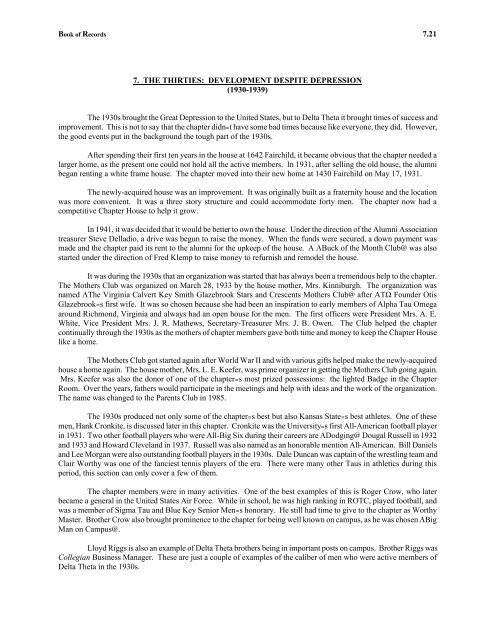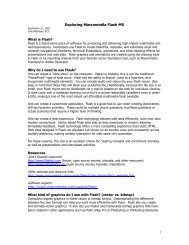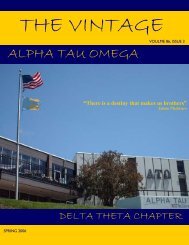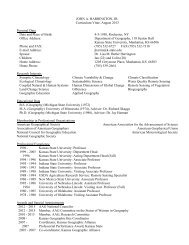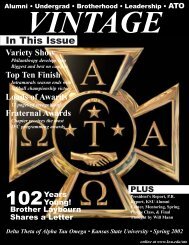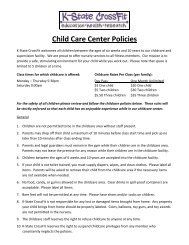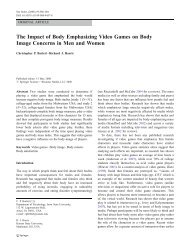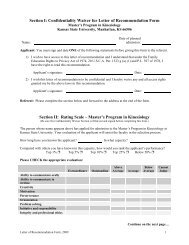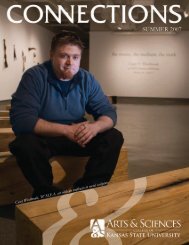book of records - Kansas State University
book of records - Kansas State University
book of records - Kansas State University
You also want an ePaper? Increase the reach of your titles
YUMPU automatically turns print PDFs into web optimized ePapers that Google loves.
Book <strong>of</strong> Records 7.21<br />
7. THE THIRTIES: DEVELOPMENT DESPITE DEPRESSION<br />
(1930-1939)<br />
The 1930s brought the Great Depression to the United <strong>State</strong>s, but to Delta Theta it brought times <strong>of</strong> success and<br />
improvement. This is not to say that the chapter didn=t have some bad times because like everyone, they did. However,<br />
the good events put in the background the tough part <strong>of</strong> the 1930s.<br />
After spending their first ten years in the house at 1642 Fairchild, it became obvious that the chapter needed a<br />
larger home, as the present one could not hold all the active members. In 1931, after selling the old house, the alumni<br />
began renting a white frame house. The chapter moved into their new home at 1430 Fairchild on May 17, 1931.<br />
The newly-acquired house was an improvement. It was originally built as a fraternity house and the location<br />
was more convenient. It was a three story structure and could accommodate forty men. The chapter now had a<br />
competitive Chapter House to help it grow.<br />
In 1941, it was decided that it would be better to own the house. Under the direction <strong>of</strong> the Alumni Association<br />
treasurer Steve Delladio, a drive was begun to raise the money. When the funds were secured, a down payment was<br />
made and the chapter paid its rent to the alumni for the upkeep <strong>of</strong> the house. A ABuck <strong>of</strong> the Month Club@ was also<br />
started under the direction <strong>of</strong> Fred Klemp to raise money to refurnish and remodel the house.<br />
It was during the 1930s that an organization was started that has always been a tremendous help to the chapter.<br />
The Mothers Club was organized on March 28, 1933 by the house mother, Mrs. Kinniburgh. The organization was<br />
named AThe Virginia Calvert Key Smith Glazebrook Stars and Crescents Mothers Club@ after ΑΤΩ Founder Otis<br />
Glazebrook=s first wife. It was so chosen because she had been an inspiration to early members <strong>of</strong> Alpha Tau Omega<br />
around Richmond, Virginia and always had an open house for the men. The first <strong>of</strong>ficers were President Mrs. A. E.<br />
White, Vice President Mrs. J. R. Mathews, Secretary-Treasurer Mrs. J. B. Owen. The Club helped the chapter<br />
continually through the 1930s as the mothers <strong>of</strong> chapter members gave both time and money to keep the Chapter House<br />
like a home.<br />
The Mothers Club got started again after World War II and with various gifts helped make the newly-acquired<br />
house a home again. The house mother, Mrs. L. E. Keefer, was prime organizer in getting the Mothers Club going again.<br />
Mrs. Keefer was also the donor <strong>of</strong> one <strong>of</strong> the chapter=s most prized possessions: the lighted Badge in the Chapter<br />
Room. Over the years, fathers would participate in the meetings and help with ideas and the work <strong>of</strong> the organization.<br />
The name was changed to the Parents Club in 1985.<br />
The 1930s produced not only some <strong>of</strong> the chapter=s best but also <strong>Kansas</strong> <strong>State</strong>=s best athletes. One <strong>of</strong> these<br />
men, Hank Cronkite, is discussed later in this chapter. Cronkite was the <strong>University</strong>=s first All-American football player<br />
in 1931. Two other football players who were All-Big Six during their careers are ADodging@ Dougal Russell in 1932<br />
and 1933 and Howard Cleveland in 1937. Russell was also named as an honorable mention All-American. Bill Daniels<br />
and Lee Morgan were also outstanding football players in the 1930s. Dale Duncan was captain <strong>of</strong> the wrestling team and<br />
Clair Worthy was one <strong>of</strong> the fanciest tennis players <strong>of</strong> the era. There were many other Taus in athletics during this<br />
period, this section can only cover a few <strong>of</strong> them.<br />
The chapter members were in many activities. One <strong>of</strong> the best examples <strong>of</strong> this is Roger Crow, who later<br />
became a general in the United <strong>State</strong>s Air Force. While in school, he was high ranking in ROTC, played football, and<br />
was a member <strong>of</strong> Sigma Tau and Blue Key Senior Men=s honorary. He still had time to give to the chapter as Worthy<br />
Master. Brother Crow also brought prominence to the chapter for being well known on campus, as he was chosen ABig<br />
Man on Campus@.<br />
Lloyd Riggs is also an example <strong>of</strong> Delta Theta brothers being in important posts on campus. Brother Riggs was<br />
Collegian Business Manager. These are just a couple <strong>of</strong> examples <strong>of</strong> the caliber <strong>of</strong> men who were active members <strong>of</strong><br />
Delta Theta in the 1930s.


